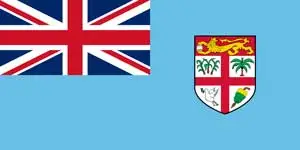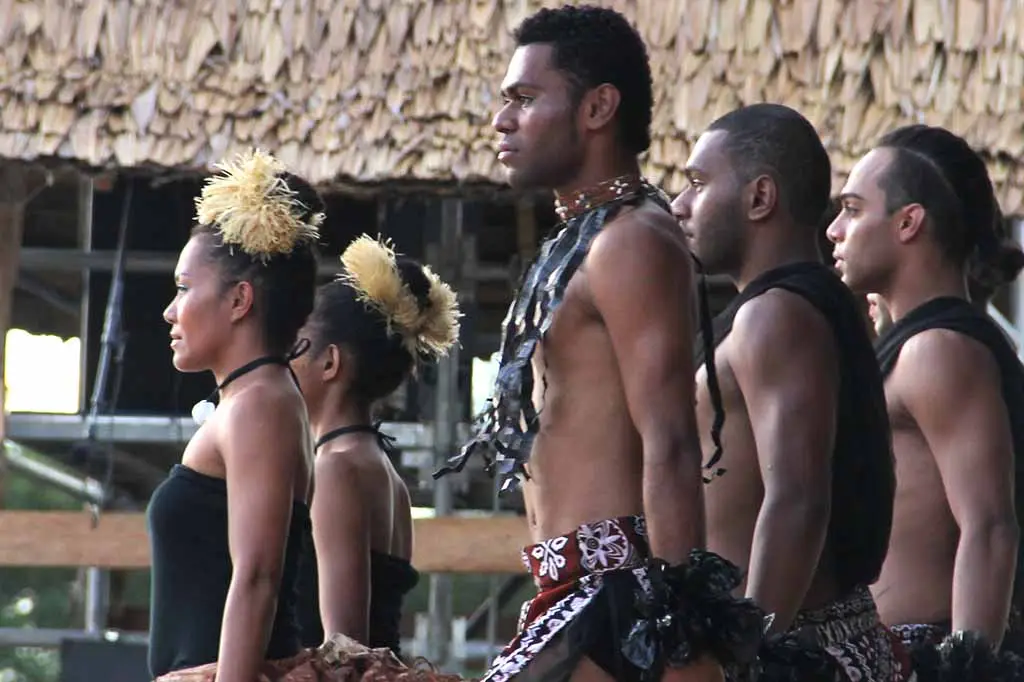POP Cultures: Fiji
Table of Contents
Share This
Map
Flag

Quick facts
Official Name: Republic of Fiji/Mantitu Tugalala o Viti
Indigenous Peoples: iTuakai
Official Languages: Fijian Bau, Fiji Hindi, and English
Political Status: Independent Nation, in association with Great Britain and the Commonwealth of Nations
Capital: Suva
Population: 909,389 (2015 est.)
Greeting: Bula (mbula)
Audio bite from Fijian language lesson 1 Ben Tui
History and geography

The Republic of Fiji is a Melanesian island nation located about 1,770 km (1,100 miles) northeast of New Zealand. Its closest neighbor countries are Vanuatu, New Caledonia, Tonga, the Samoas, Tuvalu, and Wallis and Futuna. Comprised of about 333 islands and 500 islets, only about 110 of the islands are inhabited. The total land area of Fiji is about 18,000 sq km (7,100 sq mi), with two major islands, Viti Levu and Vanua Levu, where most of the population resides. The capital, Suva, is located in Viti Levu. There are fourteen provinces and one dependency (Rotuma).
The islands are volcanic, with some high mountains on the larger islands, lush rain forests, pine forests, blue lagoons and white sand beaches. Weather is warm and tropical, with cooler months from May to November.
Fiji is one of the most developed Pacific Island nations because of its rich land and sea resources. Tourism and sugar exports make up the bulk of Fiji’s economy, as well as remittances from Fijians working abroad. The country is headed by an elected President (chief of state), a presidentially appointed Prime Minister, and a unicameral legislature.
The main islands of Fiji are believed to have been settled as early as 5,000 years ago, initially by Austronesian-speaking peoples from southeast Asia, and later by Melanesians. These early Austronesian peoples were part of the Lapita cultural complex found in much of the South Pacific and the predecessor to Polynesian culture. The proximity to Polynesia has also resulted in Polynesian cultural influences among the Fijian islanders. There is evidence through canoe remains, pottery shards and language that the inhabitants of the Fiji islands continuously interacted and traded with their Polynesian counterparts, long before the arrival of Europeans in the Pacific.
There are many different languages spoken in Fiji, and the islands were never fully united in pre-Contact times, but over the centuries a uniquely Fijian culture developed. The Fijians were known as fierce warriors and practiced cannibalism. The Europeans largely avoided these islands because of their reputation as a dangerous, unwelcoming place.
The “discovery” of the Fiji islands by Europeans was largely accidental. In 1643, Dutch explorer Abel Tasman landed in Fiji, and even British explorer James Cook passed by them. British captain William Bligh of the Bounty, though, is credited with recording the islands when he passed through in 1789. However, it was not until the beginning of the 19th century that the first European settlers arrived—beachcombers, missionaries, whalers, and traders in sandalwood and beche-de-mer. The arrival of the missionaries fairly quickly put a stop to cannibalism. In the 1800s, a Fijian chief named Ratu Seru Epenisa Cakobau converted to Christianity and united some of the warring tribes. He declared himself the king of Fiji and its protector after the islands were ceded to the United Kingdom in 1874. From 1879 to 1916, the British brought in indentured laborers from India to work on sugar plantations. Although the Fijians were not allowed to work the plantations, many of them died from diseases brought in by the Europeans. When the indentured labor system ended in the early 1900s, many of the Indians stayed and their descendants now make up about 44% of the population.
During World War II, Fiji found itself, along with the Solomons, New Caledonia and the New Hebrides (Vanuatu) on the front line of the Pacific War. Suva, with its large natural harbor, and Nandi Bay became the United States Navy’s choice for its main advance naval base. A concrete airstrip was built and Fiji became one of several targets of the Japanese war effort to capture the south Pacific and Australia. The defeat at Midway Island foiled Japan’s plans, however. Fijian soldiers participated in the difficult American Solomon Islands campaign, but afterwards, Fiji gradually became a remote rear area used for staging and logistics.
In 1970, Fiji gained its independence and democratic rule was established. However, military coups in the late 1980s destabilized the country. Although more complex, these coups were partially borne from the perception that the Indo-Fijian (Indian) community dominated the government. By 1990, the ethnic Fijians dominated the political system. A new constitution was established in 1997 as Fiji’s leadership tried to address the civil unrest and economic difficulties. Further coups in the 2000s have occurred, attributed to a frustration with government corruption.
Fiji, along with other former British colonies, is a member state of the Commonwealth of Nations, although it had been suspended several times because of its political instability. The latest suspension was lifted in 2014.
Arts and culture

The people of Fiji are mostly native Fijian or Melanesian, though many have some Polynesian ancestry as well. Relative to other Melanesian people in places like Vanuatu and the Solomon Islands, the people of Fiji are described as physically larger. At the time of European contact, they lived in a feudal society where the chiefs had absolute power over the commoners, unlike in other Melanesian societies where chiefs generally earned their status by their wealth and how much they shared with others. They maintained trade networks with people from other islands groups, including Tonga (from where the word “Fiji” actually is derived; “Viti” is what the native Fijians called their islands), Wallis and Futuna, and even Micronesia, most likely Kiribati. Indeed, traditional Fijian sailing canoes more closely resemble Micronesian canoes.
The Indo-Fjians are the next largest ethnic group, and a small percentage of Fijians are Rotuman, natives of Rotuma Island, which culturally is more similar to Tonga or Samoa than with the rest of Fiji. There are also people of Chinese and European ancestries. The most evident ethnic tension is between ethnic Fijians and Indo-Fijians in the realm of politics. The main languages are Fijian Bau, Fiji-Hindi and English. The main dialects of Fijian are called eastern and western. Missionaries who came to the islands in the 1840s used mostly the Eastern dialect.
The ancient Fijians had a complex system of religion and ritual that involved the worshiping of deities, spirits in nature, sorcery and human sacrifice. The people of Fiji today, in general, are deeply religious, with Christianity, Hinduism and Islam representing the major religions. Methodism and Roman Catholicism are the main Christian denominations in Fiji. Yaqona or kava drinking is also an important part of Fijian culture. The drink is made from the pounded root of Piper methysticum, a type of pepper plant and in olden days was used primarily for ceremonies.
Fiji is also well known for its architecture and other art forms. In pre-Contact times, artisans would build impressive, large war canoes, and decorate temples (bure kalou–spirit house) and chief houses (vale levu) with strings of cowry shells and large masi (barkcloth/tapa). Pottery making is a special craft of Fijian islanders, with different pottery styles characteristic among the different provinces, including bowls, plates and other items. Interestingly, it is almost always the women who are potters. They knead the clay, then add sand to control shrinkage.
Mat-weaving is an important skill and is taught to nearly all girls. Palm fronds or pandanus leaves are woven into mats that become floor coverings, sleeping mats, fans and baskets. Traditional homes called bure are also constructed from plaited leaves. Often, mats are given as gifts to high chiefs, or at weddings and funerals.
The Fijians also have a bark cloth tradition which they call masi. Masi is produced from the inner bark of the mulberry plant. The process for making barkcloth is time consuming and physically demanding, but the finished product can used for ceremonial dress, wall coverings or other utilitarian items. They are often decorated with geometric designs.
The salusalu is a type of Fijian neck wreaths made by women. The basic circle of the salusalu is made out of the bark of the vau or wild hibiscus plant. The bark is cut into 10-inch lengths which are then folded in half and tied at the fold resulting in a half-inch thickness and forming a tassel. Approximately 22 tassels are needed to complete a salusalu, though more tassels can be added to increase the length. The tassel is refined by stripping it into fine threads. To decorate the salusalu, flowers, leaves and feathers are added. The salusalu are worn during festivals, birthdays, anniversary celebrations, holidays, and other special occasions.
Fijian culture is also known for impressive wood carving, which is performed by men. Most carved items include war clubs which were used as weapons and symbols of a warrior’s power and authority, and tanoa or yaqona bowls, used for yaqona (or kava) drinking at important ceremonies. Men also carve canoes, including the impressive, huge war canoes called drua, and the smaller camakau.
There are different traditional dances, such as the meke. The meke may include the women’s fan dance, or the men’s spear dance, and would usually narrate an important event or the installation of a chief.
